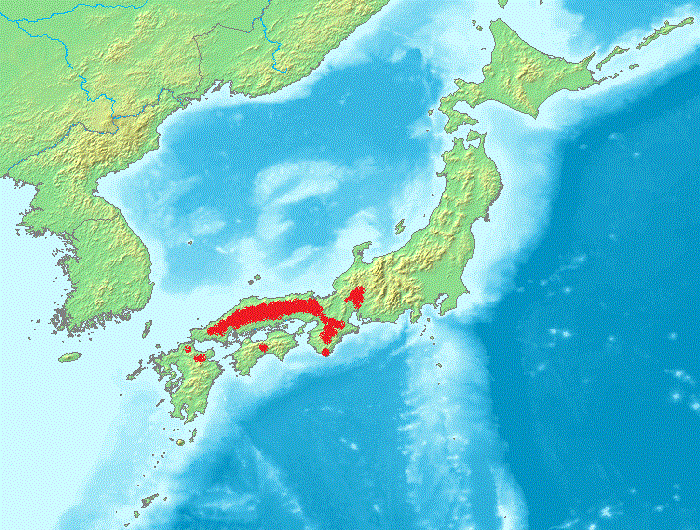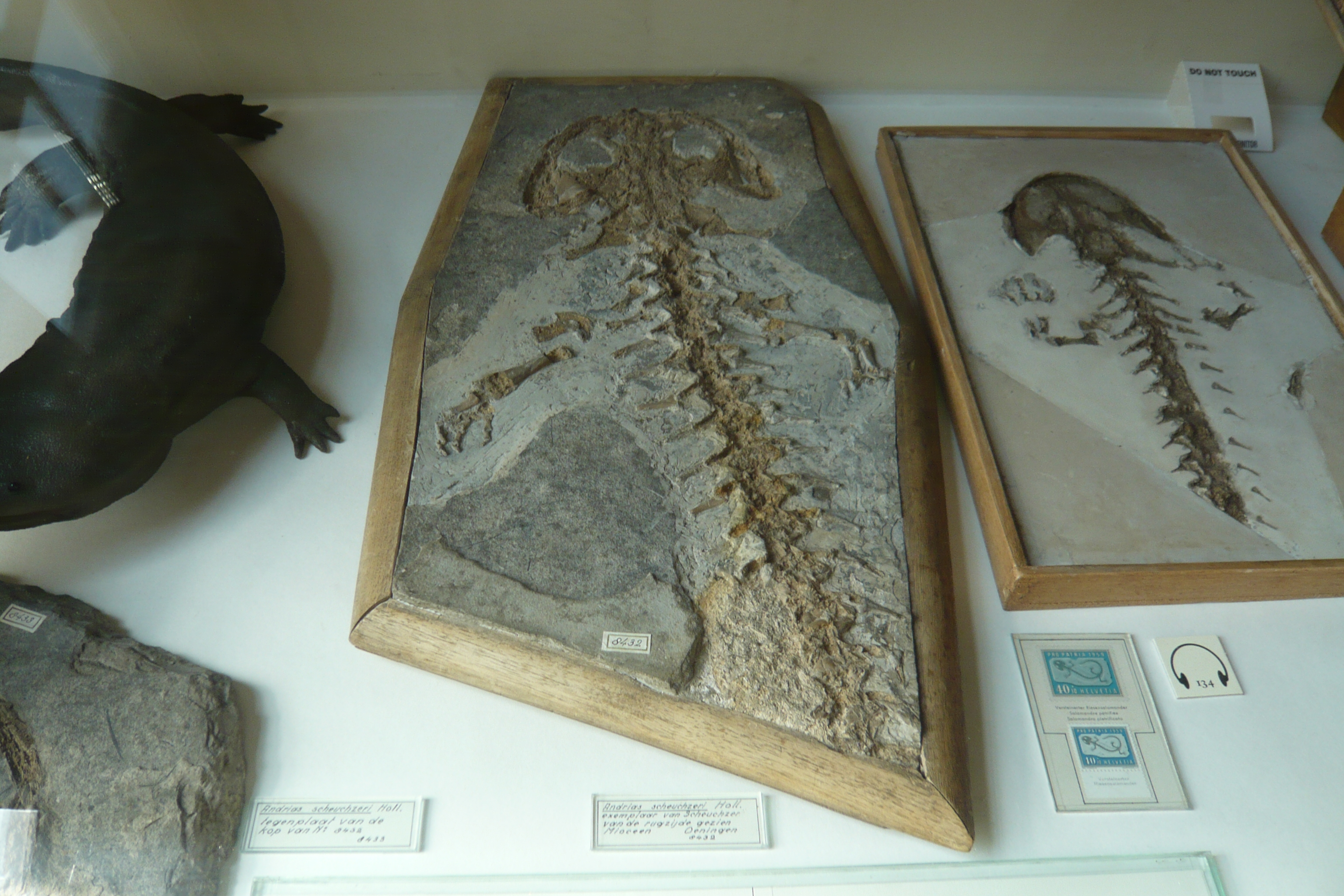|
Eastern Hellbender
The hellbender (''Cryptobranchus alleganiensis''), also known as the hellbender salamander, is a species of aquatic giant salamander endemic to the eastern and central United States. It is the largest salamander in North America. A member of the family Cryptobranchidae, the hellbender is the only extant member of the genus ''Cryptobranchus''. Other closely related salamanders in the same family are in the genus ''Andrias'', which contains the Japanese and Chinese giant salamanders. The hellbender, which is much larger than all other salamanders in its geographic range, employs an unusual means of respiration (which involves cutaneous gas exchange through capillaries found in its dorsoventral skin folds), and fills a particular niche—both as a predator and prey—in its ecosystem, which either it or its ancestors have occupied for around 65 million years. The species is listed as Vulnerable on the IUCN Red List of Threatened Species. Etymology The origin of the name "hellbender ... [...More Info...] [...Related Items...] OR: [Wikipedia] [Google] [Baidu] |
Pleistocene
The Pleistocene ( , often referred to as the '' Ice age'') is the geological epoch that lasted from about 2,580,000 to 11,700 years ago, spanning the Earth's most recent period of repeated glaciations. Before a change was finally confirmed in 2009 by the International Union of Geological Sciences, the cutoff of the Pleistocene and the preceding Pliocene was regarded as being 1.806 million years Before Present (BP). Publications from earlier years may use either definition of the period. The end of the Pleistocene corresponds with the end of the last glacial period and also with the end of the Paleolithic age used in archaeology. The name is a combination of Ancient Greek grc, label=none, πλεῖστος, pleīstos, most and grc, label=none, καινός, kainós (latinized as ), 'new'. At the end of the preceding Pliocene, the previously isolated North and South American continents were joined by the Isthmus of Panama, causing a faunal interchange between the t ... [...More Info...] [...Related Items...] OR: [Wikipedia] [Google] [Baidu] |
Giant Salamander
The Cryptobranchidae are a family of fully aquatic salamanders commonly known as the giant salamanders. They include the largest living amphibians. The family is native to China, Japan, and the eastern United States. They constitute one of two living families within the Cryptobranchoidea, one of two main divisions of living salamanders, the other being the Asiatic salamanders belonging to the family Hynobiidae. The largest species are in the genus '' Andrias,'' native to east Asia''.'' The South China giant salamander (''Andrias sligoi''), can reach a length of .Andrias davidianus AmphibiaWeb: Information on amphibian biology and conservation. 2012. Berkeley, California: AmphibiaWeb. Retrieved 13 December 2012. The |
Predator
Predation is a biological interaction where one organism, the predator, kills and eats another organism, its prey. It is one of a family of common feeding behaviours that includes parasitism and micropredation (which usually do not kill the host) and parasitoidism (which always does, eventually). It is distinct from scavenging on dead prey, though many predators also scavenge; it overlaps with herbivory, as seed predators and destructive frugivores are predators. Predators may actively search for or pursue prey or wait for it, often concealed. When prey is detected, the predator assesses whether to attack it. This may involve ambush or pursuit predation, sometimes after stalking the prey. If the attack is successful, the predator kills the prey, removes any inedible parts like the shell or spines, and eats it. Predators are adapted and often highly specialized for hunting, with acute senses such as vision, hearing, or smell. Many predatory animals, both vertebra ... [...More Info...] [...Related Items...] OR: [Wikipedia] [Google] [Baidu] |
Niche (ecology)
In ecology, a niche is the match of a species to a specific environmental condition. Three variants of ecological niche are described by It describes how an organism or population responds to the distribution of resources and competitors (for example, by growing when resources are abundant, and when predators, parasites and pathogens are scarce) and how it in turn alters those same factors (for example, limiting access to resources by other organisms, acting as a food source for predators and a consumer of prey). "The type and number of variables comprising the dimensions of an environmental niche vary from one species to another ndthe relative importance of particular environmental variables for a species may vary according to the geographic and biotic contexts". See also Chapter 2: Concepts of niches, pp. 7 ''ff'' A Grinnellian niche is determined by the habitat in which a species lives and its accompanying behavioral adaptations. An Eltonian niche emphasizes that a spec ... [...More Info...] [...Related Items...] OR: [Wikipedia] [Google] [Baidu] |
Dorsoventral
Standard anatomical terms of location are used to unambiguously describe the anatomy of animals, including humans. The terms, typically derived from Latin or Greek roots, describe something in its standard anatomical position. This position provides a definition of what is at the front ("anterior"), behind ("posterior") and so on. As part of defining and describing terms, the body is described through the use of anatomical planes and anatomical axes. The meaning of terms that are used can change depending on whether an organism is bipedal or quadrupedal. Additionally, for some animals such as invertebrates, some terms may not have any meaning at all; for example, an animal that is radially symmetrical will have no anterior surface, but can still have a description that a part is close to the middle ("proximal") or further from the middle ("distal"). International organisations have determined vocabularies that are often used as standard vocabularies for subdisciplines of anato ... [...More Info...] [...Related Items...] OR: [Wikipedia] [Google] [Baidu] |
Capillaries
A capillary is a small blood vessel from 5 to 10 micrometres (μm) in diameter. Capillaries are composed of only the tunica intima, consisting of a thin wall of simple squamous endothelial cells. They are the smallest blood vessels in the body: they convey blood between the arterioles and venules. These microvessels are the site of exchange of many substances with the interstitial fluid surrounding them. Substances which cross capillaries include water, oxygen, carbon dioxide, urea, glucose, uric acid, lactic acid and creatinine. Lymph capillaries connect with larger lymph vessels to drain lymphatic fluid collected in the microcirculation. During early embryonic development, new capillaries are formed through vasculogenesis, the process of blood vessel formation that occurs through a '' de novo'' production of endothelial cells that then form vascular tubes. The term '' angiogenesis'' denotes the formation of new capillaries from pre-existing blood vessels and already p ... [...More Info...] [...Related Items...] OR: [Wikipedia] [Google] [Baidu] |
Cutaneous Gas Exchange
Cutaneous respiration, or cutaneous gas exchange (sometimes called, skin breathing), is a form of respiration in which gas exchange occurs across the skin or outer integument of an organism rather than gills or lungs. Cutaneous respiration may be the sole method of gas exchange, or may accompany other forms, such as ventilation. Cutaneous respiration occurs in a wide variety of organisms, including insects, amphibians, fish, sea snakes, turtles, and to a lesser extent in mammals. Physical constraints Gas exchange in cutaneous respiration is controlled by three factors: * Ventilation: the rate of delivery of respiratory medium (water or air) to the respiratory surface *Diffusion: the passage of gases through the skin *Convection: the carrying of dissolved gases towards or away from the lungs Taxonomic diversity in chordates Fish Cutaneous respiration occurs in a variety of marine, intertidal, and freshwater fish. For aquatic respiration, fish respire primarily via gills but cut ... [...More Info...] [...Related Items...] OR: [Wikipedia] [Google] [Baidu] |
Chinese Giant Salamander
The Chinese giant salamander (''Andrias davidianus'') is one of the largest salamanders and one of the largest amphibians in the world.''Andrias davidianus'' -Amphibiaweb It is fully aquatic and is to rocky mountain streams and lakes in the river basin of central China. Either it or a close relative has been introduced to [...More Info...] [...Related Items...] OR: [Wikipedia] [Google] [Baidu] |
Japanese Giant Salamander
The Japanese giant salamander (''Andrias japonicus'') is a species of fully aquatic giant salamander endemic to Japan. With a length of up to ,''Andrias japonicus'' - Amphibiaweb it is the third-largest in the world, only being surpassed by the very similar and closely related Chinese giant salamander (''A. davidianus''). It is known in Japanese as , literally meaning "giant salamander". Other local names include ''Hanzaki'''','' ''Hanzake','' and ''Ankou''. This s ... [...More Info...] [...Related Items...] OR: [Wikipedia] [Google] [Baidu] |
Andrias
''Andrias'' is a genus of giant salamanders. It includes the largest salamanders in the world, with ''A. japonicus'' reaching a length of , and ''A. sligoi'' reaching . While extant species are only known from East Asia, several extinct species in the genus are known from late Oligocene and Neogene aged fossils collected in Europe and North America, indicating that the genus formerly had a much wider range. Taxonomy The generic name derives from Ancient Greek ἀνδριάς, "statue". The former name was ''Megalobatrachus'', from Ancient Greek meaning "giant frog". Species Extant Based on genetic evidence, there may be more extant species in the genus. A study in 2018 found that ''A. davidianus'' ''sensu lato'' was a species complex In biology, a species complex is a group of closely related organisms that are so similar in appearance and other features that the boundaries between them are often unclear. The taxa in the complex may be able to hybridize readily with eac ... [...More Info...] [...Related Items...] OR: [Wikipedia] [Google] [Baidu] |
Extant Taxon
Neontology is a part of biology that, in contrast to paleontology, deals with living (or, more generally, ''recent'') organisms. It is the study of extant taxa (singular: extant taxon): taxa (such as species, genera and families) with members still alive, as opposed to (all) being extinct. For example: * The moose (''Alces alces'') is an extant species, and the dodo (''Raphus cucullatus'') is an extinct species. * In the group of molluscs known as the cephalopods, there were approximately 600 extant species and 7,500 extinct species. A taxon can be classified as extinct if it is broadly agreed or certified that no members of the group are still alive. Conversely, an extinct taxon can be reclassified as extant if there are new discoveries of living species (" Lazarus species"), or if previously-known extant species are reclassified as members of the taxon. Most biologists, zoologists, and botanists are in practice neontologists, and the term neontologist is used ... [...More Info...] [...Related Items...] OR: [Wikipedia] [Google] [Baidu] |
Cryptobranchidae
The Cryptobranchidae are a family of fully aquatic salamanders commonly known as the giant salamanders. They include the largest living amphibians. The family is native to China, Japan, and the eastern United States. They constitute one of two living families within the Cryptobranchoidea, one of two main divisions of living salamanders, the other being the Asiatic salamanders belonging to the family Hynobiidae. The largest species are in the genus ''Andrias,'' native to east Asia''.'' The South China giant salamander (''Andrias sligoi''), can reach a length of .Andrias davidianus AmphibiaWeb: Information on amphibian biology and conservation. 2012. Berkeley, California: AmphibiaWeb. Retrieved 13 December 2012. The [...More Info...] [...Related Items...] OR: [Wikipedia] [Google] [Baidu] |


_with_its_prey.jpg)




